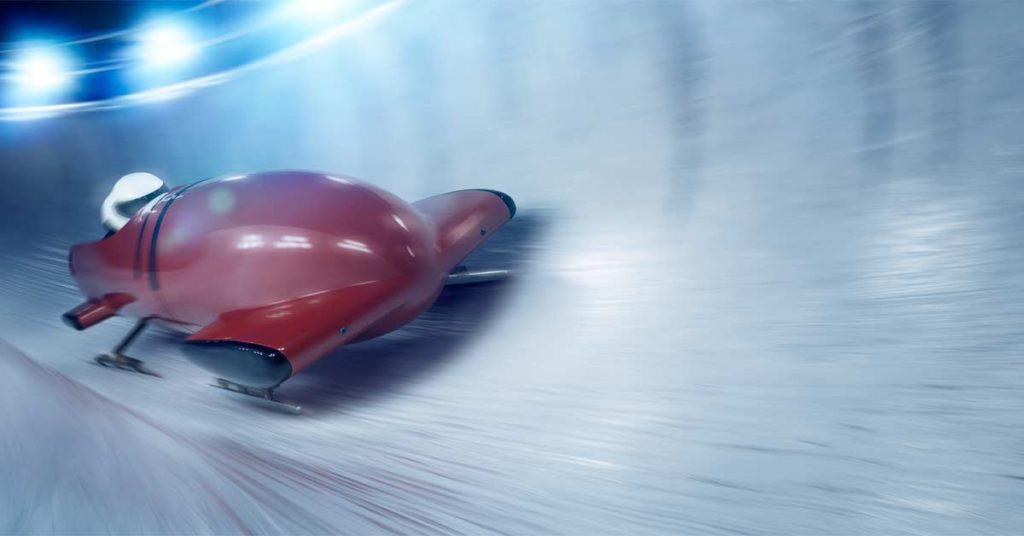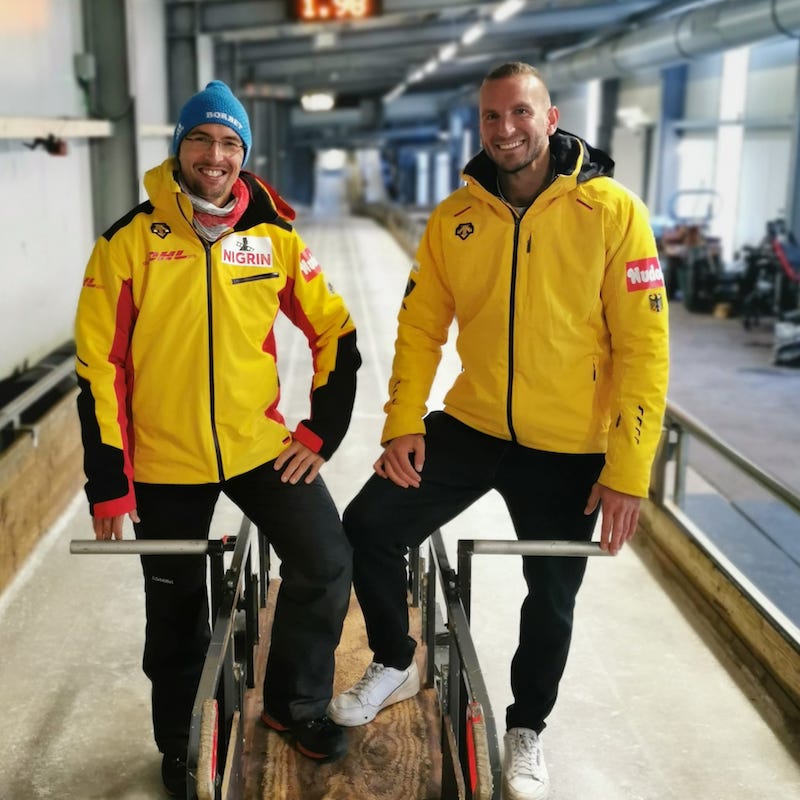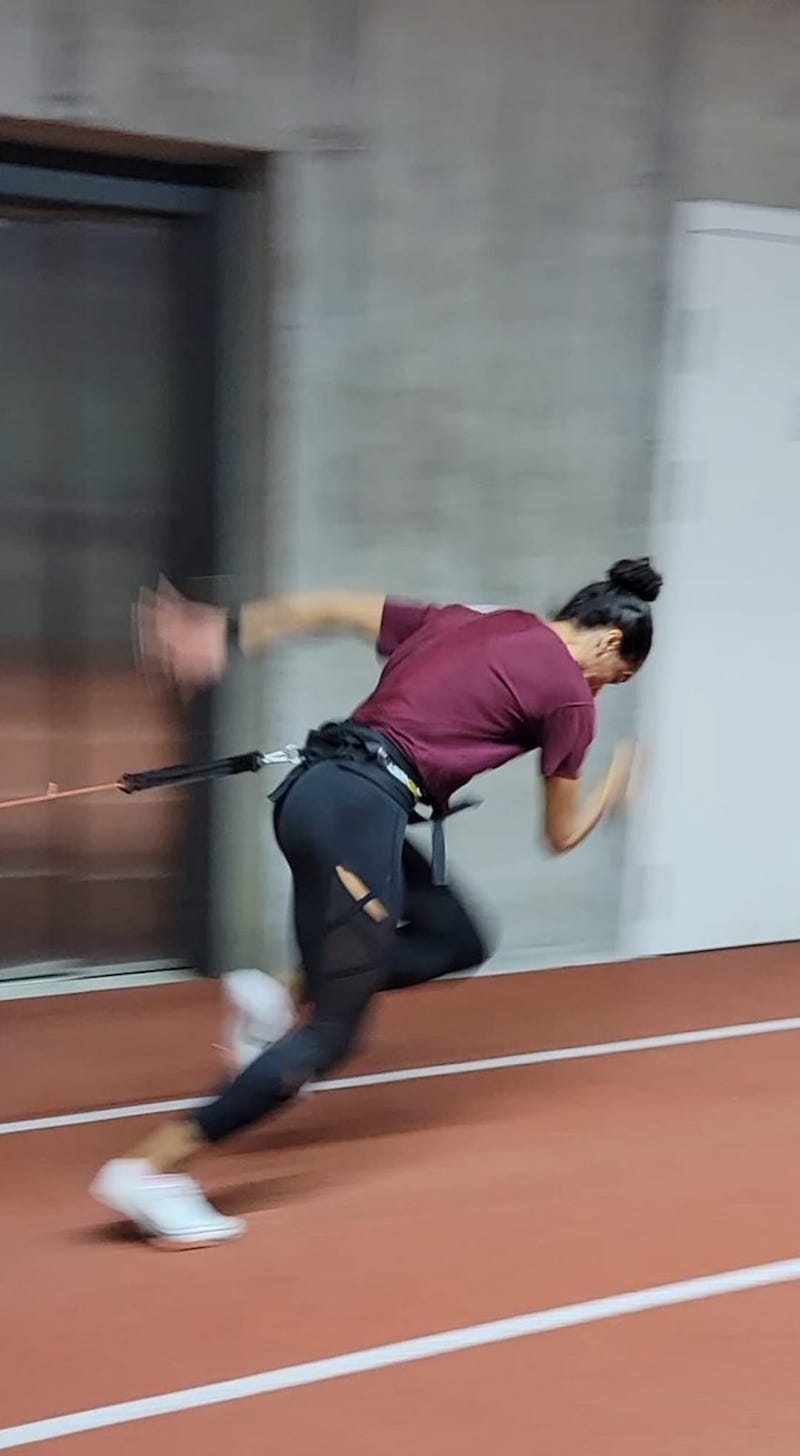
Pat Saile is Switzerland’s national coach for track and field, coaching the men’s relay. He currently works with two German athletes and an Austrian sprinter and has had five athletes win medals at the Winter Olympics. Coach Saile previously studied sports science and worked in biomechanics with 3D motion capture. He then worked as a football and athletics coach before moving to Munich to work as a Bavaria country coach for bobsled and track and field.
Coach Saile has many coaching licenses and experience in different sports, such as disabled sports, football/soccer, CrossFit, weightlifting, etc.
Freelap USA: There have been several athletes who have competed at a high level in sprinting and bobsled, and this is your background also. What are some of the training methods that you have experienced in bobsled that influence your programming when coaching sprinters?
Pat Saile: I use the prowler and heavy sled like I use the bobsled, and I do this to get into angles and specific positions that I want to see in acceleration training. I also work relatively similarly in explosive strength development.
The hard part of bobsledding is getting the 100-kilogram-plus men to move explosively and quickly while still making them look smooth so they can sprint quickly. Share on XThe hard part of bobsledding is getting the 100-kilogram-plus men to move explosively and quickly while still making them look smooth so they can sprint quickly. They are sometimes as fast as the sprinters, up to 40 meters.

The bobsledders also have to run down in the dip to over 11 m/s before they jump in the sled. For example, if an athlete has problems with frontside mechanics in the pick-up phase, it makes methodical sense from time to time to let the athlete accelerate (while holding at the bars in front) on the curved treadmill. In this way, we often find good positions with younger athletes for the pick-up acceleration.
Freelap USA: Alex Burghardt competed in the 2022 Winter Olympics just 196 days after competing at the 2021 Summer Olympics, before being ready for the 2022 track and field season. How tough was this, and what challenges did you face when preparing her for this?
Pat Saile: Since I had already worked in bobsled and knew the specifics of the sport, it was clear to me that the project could be successful. Alexandra had already been asked several times if she would like to try to push a bobsled, and it is often the case in Germany that second-tier sprinters switch to bobsled if they have not been so successful in sprinting. However, she did not want that.
But after she ran 11.07 in the Olympic semifinals, she was okay with it, and I gave her the option to participate in the Winter Olympics six months after the Tokyo Olympics. She was a bit incredulous at first, but then she came in second—a hundredth behind—at the national push test in Oberhof one day before the ISTAF meeting in Berlin. Of course, we still had to train push-off technique in the track and field season before, but because of her longer contact times in the acceleration phase and her body weight of 73 kilograms, she was predestined for bobsled.
The problem for the track and field season was rather that we could not lay much foundation for the summer season during the bobsled season.
Then COVID-19, norovirus, and a minor injury were added in the summer build-up, and suddenly we had to run 200 meters in Munich for the National Federation. In addition, she had slight back problems in the summer season due to the strong G-forces in bobsledding.
We are now working through all this and looking forward to a season in 2023. All in all, those 1 1/2 years were very exhausting and energy-sapping.
Freelap USA: You share coaching responsibilities for Mujinga Kambundji with Florian Clivaz, and before that, with Adrian Rothenbühler. Can you explain how the coaching duties are split and what you have been working on with her? She has had a sensational career and won her first global title over 60 meters last year in Belgrade. Was there any indication in training that she would run that fast?
Pat Saile: That’s right, I try to help her main coaches with the technical stuff like running mechanics and acceleration and give them advice if needed. I am also present at every major international event and help with coaching.
Once a week, Mujinga comes to me in Zurich, and once a week, I go to her and her training group for coaching in Bern. The training plans are made by her home coach Florian (and earlier, that was done by Adrian). Mondays are sprint sessions with lots of warm-up and coordination drills beforehand.

On Wednesdays, the focus is on acceleration. Here, we mainly work with the 1080 Sprint and try to find the angle-specific positions of the acceleration. Last season, Mujinga was internationally one of the strongest athletes in acceleration. This has also been shown during competitions in Eugene and Munich.
In Belgrade, she was only able to unpack this in the final. There, in the semifinals, we were still working on the initial movement out of the block. In the final, the warm-up was all about emotion, so I withdrew from coaching (Adrian did all the work) and maybe only gave 1–2 mini inputs.
In the technique training itself, we mainly work on generating more beautiful and economical step patterns.
In technique training itself, we mainly work on Mujinga generating more beautiful and economical step patterns. Share on XIt is very remarkable what she is able to achieve in competition and what it often looks like in training. Mujinga often does not reach the load peaks in training, which is why she is able to run overspeed in training more often than other athletes.
And, yes, her coach told me that she was able to run fast in Belgrade because he measured the times with the 1080 Sprint and checked if she still could run actively with that speed, so we knew what she was able to do.
Freelap USA: You have access to an indoor straightaway but not an indoor 200-meter track, and the Swiss winters can be harsh. To what extent does this influence your programming?
Pat Saile: It is currently -5 degrees Celsius with snow outside. Therefore, we must adjust to slower speeds for the longer runs and run fast indoors. This means that we run, for example, 200-meter programs with short pauses or second runs just to get “fit.”
It is very important to me that the athletes come out of a preparation period healthy and physically fit. However, I always try to run qualitatively fast once a week. I design different running programs indoors with ASSE and GSSE versions and try to trigger the important energy systems.
But I try not to let the athletes know that. I give the workouts themes like acceleration sprint or longer tempo. Just before the indoor season, we usually go to a warmer place like Tenerife and fine-tune with faster tempo runs and top speed running for the indoor season.
Freelap USA: One of the differences I have noticed between programming in the U.S. and programming in Europe is that American coaches are more likely to have a track session and a weight training session on the same day, whereas European coaches may have them on separate days. How do you approach this and why? Could you outline a weekly cycle of your training?
Pat Saile: I am well aware that the weekly structure of many American coaches is Monday and Tuesday running and weight room, Wednesday easy, and Thursday and Friday again running plus weight room.
For us, it often has a cultural background. We have many athletes who are non-professional athletes and still go to college or school or work on the side. Professionalization has only progressed significantly in Switzerland in recent years. That’s why we often don’t pack all the training content into one session; otherwise, we would be in the facility for far too long.
In addition, our athletes are often not used to running every day, and then they struggle and might get overuse injuries. Also, we often don’t have the opportunity to run on flat grass because good grass gets blocked off for football/soccer training or competition. That’s why we often do alternative programs on the bike, skip one running session, and do a longer weight session.
When we travel to warmer climates, we have a different rhythm and run more often. Since I am also trying to generate a higher level of stress tolerance with my group and would like to run more often, my rhythm in this preparation phase is as follows:
-
Monday: Many technical drills/circuit/longer running
Tuesday: Acceleration/1 x 300m/weight room
Wednesday: Bike/core/active regeneration
Thursday: Max V sprinting, sprint mechanics
Friday: Weights/jumps
Saturday: Sprint mechanics/longer running
Since you’re here…
…we have a small favor to ask. More people are reading SimpliFaster than ever, and each week we bring you compelling content from coaches, sport scientists, and physiotherapists who are devoted to building better athletes. Please take a moment to share the articles on social media, engage the authors with questions and comments below, and link to articles when appropriate if you have a blog or participate on forums of related topics. — SF

